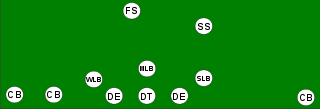 W
WIn American football, the 3–3–5 defense is a defensive alignment consisting of three down linemen, three linebackers, and five defensive backs. The 3–3–5 defense can also be referred to as the 3-3 stack and the Spread Defense. It is one form of the nickel defense, a generic term for a formation with five defensive backs. Veteran college football defensive coordinator Joe Lee Dunn is widely credited with being the main innovator of the 3-3-5 scheme.
 W
WIn American football, the 3–4 defense is a common defensive alignment consisting of three down linemen and four linebackers. It is a called a "base defense" because it is the default defensive alignment used on "base downs". However, defenses will readily switch to other defensive alignments as circumstances change. Alternatively, some defenses use a 4–3 defense.
 W
WIn American football, a 4–3 defense is a defensive alignment consisting of four down linemen and three linebackers. It is called a "base defense" because it is the default defensive alignment used on "base downs". However, defenses will readily switch to other defensive alignments as circumstances change. Alternatively, some defenses use a 3–4 defense.
 W
WIn American football, the 4–4 defense is a defensive alignment consisting of four down linemen and four linebackers.
 W
WIn American football, the 5–2 defense is a defensive alignment consisting of five down linemen and two linebackers.
 W
WThe 7–1–2–1, or seven-diamond defense, used seven "down linemen", or players on the line of scrimmage at the time of the snap, one linebacker, two safeties relatively close to the line and one safety farther downfield. The formation was created by Minnesota coach Henry L. Williams in 1903, reputedly to stop Michigan back Willie Heston. By some accounts in the mid-1930s, the 7-1-2-1 was considered "almost obsolete" due to its weakness against the forward pass, whereas the 7-2-2 defense was still considered viable. Yet Bill Arnsparger notes the use of the seven-diamond from the 1940s into the 1960s, as a defensive adjustment to the common wide tackle 6 defenses of the time. Further, the form of the 7 diamond as derived from a wide tackle 6, with a more compact line spacing than the 1930s era 7 man lines, shows a marked similarity to the 46 defense of Buddy Ryan.
 W
WThe 7–2–2 defense or seven-box defense, used seven "down linemen", or players on the line of scrimmage at the time of the snap, two linebackers, and two safeties. Amos Alonzo Stagg invented the seven-box defense in 1890 at Springfield College. At that time, most teams were using a nine-man line on defense, and there were only three downs and no forward passes. The 7–2–2 was the base defense used by Knute Rockne at Notre Dame, as well as Mike Donahue at Auburn. Into the late 1930s, the 7–2–2 was still commonly employed inside the defender's thirty-yard line. It was considered "very strong against a running attack, but rather weak defensively against passes." The 7–2–2 was also employed when the opponent was expected to punt.
 W
WThe 46 defense is an American football defensive formation, an eight men in the box defense, with six players along the line of scrimmage. There are two players at linebacker depth playing linebacker technique, and then three defensive backs. The 46 defense was originally developed and popularized with the Chicago Bears by their defensive coordinator Buddy Ryan, who later became head coach of the Philadelphia Eagles and Arizona Cardinals.
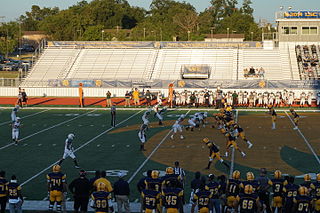 W
WIn American football, the dime defense is a defensive alignment that uses six defensive backs. It is usually employed in obvious passing situations. The formation usually consists of six defensive backs, usually two safeties, and four cornerbacks, and has either four down linemen and one linebacker, or three down linemen and two linebackers. This formation is used to prevent the offense from completing a medium- to long-range pass play. This may be because the offense's running game is inefficient, time is an issue, or they need a long pass for a first down. It is also used against teams whose pass-to-run ratio predominantly favors pass. The formation, however, is vulnerable to running plays as the formation is missing two linebackers, or a linebacker and a down lineman.
 W
WThe flexbone formation It is an offensive formation in American football that includes a quarterback, five offensive linemen, three running backs, and varying numbers of tight ends and wide receivers. The flexbone formation is a predominant turnover formation derived from the wishbone formation and it features a quarterback under center with a fullback lined up directly behind the quarterback. There are two smaller running backs called slotbacks aligned behind the line of scrimmage on each side of the offensive line. The slotbacks are sometimes incorrectly referred to as wingbacks. But in order to be a wingback, there must be a guard, tackle and tight end all on one side of the center on the line of scrimmage and then the wingback off the line of scrimmage.
 W
WThe I formation is one of the most common offensive formations in American football. The I formation draws its name from the vertical alignment of quarterback, fullback, and running back, particularly when contrasted with the same players' alignments in the T formation.
 W
WThe Miami 4–3, also called the 4–3 slide, is a scheme closely associated with the Jimmy Johnson-led Miami Hurricanes, and taken by Johnson to the Dallas Cowboys. Built around Jimmy Johnson's notion of "upfield pressure", it is a penetrating, swarming defense, with a "get there firstest with the mostest" mentality. The focus is to cause opponents to make mistakes, even if the defense might give up a big gain or two. Compared to older 4–3 defenses, such as Tom Landry's 4–3 inside, the defensive line assignments are simpler. Linemen don't read then react, they act then read. Linebackers fill the gaps the linemen leave behind, ignoring gaps away from the play. Coverages are simple, and the playbook small and easy to learn.
 W
WIn American football, a nickel defense is any defensive alignment that uses five defensive backs, of whom the fifth is known as a nickelback. The original and most common form of the nickel defense features four down linemen and two linebackers. Because the traditional 4–2 form preserves the defense's ability to stop an opponent's running game, it has remained more popular than its variants, to the extent that even when another formation technically falls within the "nickel" definition, coaches and analysts will refer to it by a more specific designation that conveys more information with equal or greater conciseness.
 W
WThe Notre Dame Box is a variation of the single-wing formation used in American football, with great success by Notre Dame in college football and the Green Bay Packers of the 1920s and 1930s in the NFL. Green Bay's coach, Curly Lambeau, learned the Notre Dame Box while playing for Knute Rockne in the late 1910s. Rockne learned it from Jesse Harper, who learned it from coach Amos Alonzo Stagg. It contained two ends, and four backs. The formation often featured an unbalanced line where the center was not strictly in the center of the line, but close to the weakside.
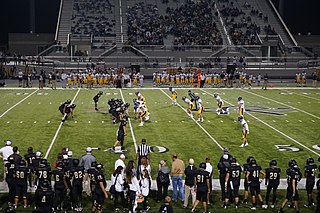 W
WIn American football, the pro set or split backs formation is a formation that was commonly used as a "base" set by professional and amateur teams. The "pro set" formation featured an offensive backfield that deployed two running backs aligned side-by-side instead of one in front of the other as in traditional I-formation sets. It was an outgrowth of the three running back T-formation, with the third running back in the T becoming a permanent flanker, now referred to as a wide receiver.
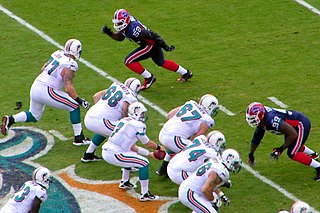 W
WA pro-style offense in American football is any offensive scheme that resembles those predominantly used at the professional level of play in the National Football League (NFL), in contrast to those typically used at the collegiate or high school level. Pro-style offenses are fairly common at top-quality colleges but much less used at the high school level. The term should not be confused with a pro set, which is a specific formation that is used by some offenses at the professional level.
 W
WThe short punt formation is an older formation on both offense and defense in American football, popular when scoring was harder and a good punt was itself an offensive weapon. In times when punting on third down was fairly common, teams would line up in the short punt formation and offer the triple threat of punt, run or pass. Harper's Weekly in 1915 called it "the most valuable formation known to football."
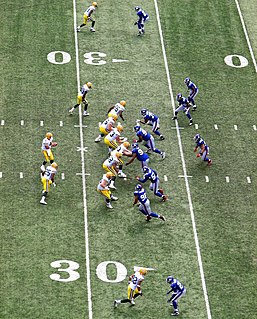 W
WThe shotgun formation is a formation used by the offensive team in gridiron football mainly for passing plays, although some teams use it as their base formation. Instead of the quarterback receiving the snap from center at the line of scrimmage, in the shotgun he stands farther back, often five to seven yards off the line. Sometimes the quarterback will have a back on one or both sides before the snap, while other times he will be the lone player in the backfield with everyone spread out as receivers.
 W
WSingle set back is an offensive base formation in American Football which requires only one running back lined up about five yards behind the quarterback. There are many variations on single back formations including two tight ends and two wide receivers, one tight end/three wide receivers, etc. The running back can line up directly behind the quarterback or offset either the weak side or the strong side.
 W
WThe spread offense is an offensive scheme in gridiron football that typically places the quarterback in the shotgun formation, and "spreads" the defense horizontally using three-, four-, and even five-receiver sets. Used at every level of the game including professional, college, and high school programs across the US and Canada, spread offenses often employ a no-huddle approach. Some implementations of the spread also feature wide splits between the offensive linemen.
 W
WIn American football, a T formation is a formation used by the offensive team in which three running backs line up in a row about five yards behind the quarterback, forming the shape of a "T".
 W
WThe Veer is an option running play often associated with option offenses in American football, made famous at the collegiate level by Bill Yeoman's Houston Cougars. It is currently run primarily on the high school level, with some usage at the collegiate and the professional level where the Veer's blocking scheme has been modified as part of the zone blocking system. The Veer is an effective ball control offense that can help minimize mismatches in a game for a team. However, it can lead to turnovers with pitches and handoff option reads.
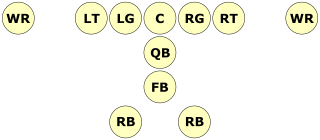 W
WThe wishbone formation, also known simply as the bone, is an offensive formation in American football. The style of attack to which it gives rise is known as the wishbone offense. Like the spread offense in the 2000s, the wishbone was considered to be the most productive and innovative offensive scheme in college football during the 1970s and 1980s.
 W
WZone coverage is a defense scheme in gridiron football used to protect against the pass.